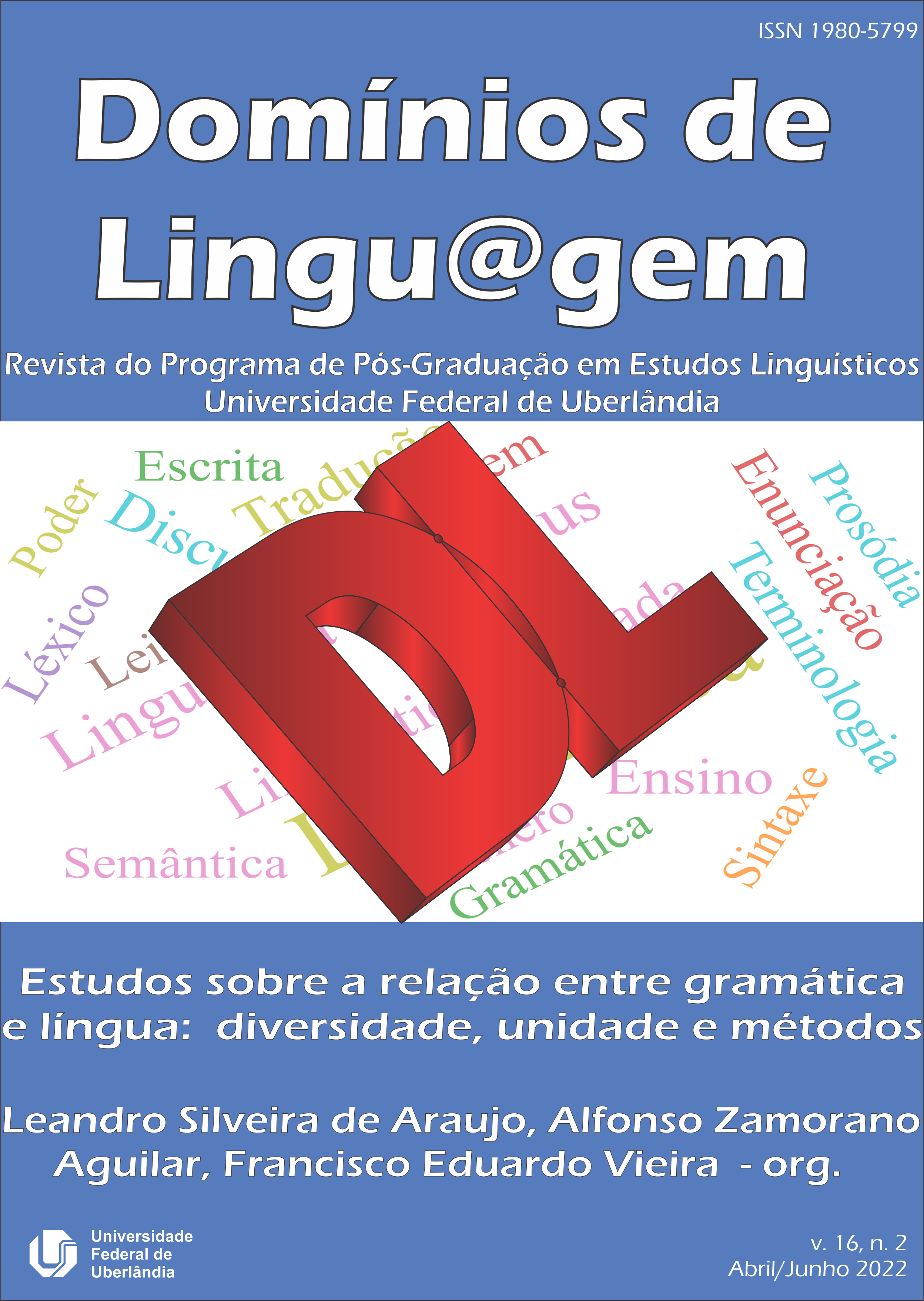Why to write grammars of emerging sign languages
DOI:
https://doi.org/10.14393/DL50-v16n2a2022-12Keywords:
Grammatization, Emerging sign languages, Conventionalization, Institutionalized sign languagesAbstract
This article discusses the conceptions inherent to the processes of grammatization in emerging sign languages in relation to institutionalized sign languages. It is also discussed the case of some emerging sign languages and the discussion about variation and conventionalization in young languages and more consolidated sign languages. A reflection on the description, documentation and linguistic revitalization procedures suggested in the production of reference grammars of signed languages is applied to this study. Arguments are presented to theorize the concept of conventionalization based on Schmid's E-C Model (2020). As a result, it is shown that the grammatization of emerging sign languages in relation to the grammatization of institutionalized sign languages differs more by their glotopolitical and ideological aspects than by their linguistic ones.
Downloads
References
ALMEIDA-SILVA, A.; NEVINS, A. I. Observações sobre a estrutura linguística da Cena: a língua de sinais emergente da Várzea Queimada (Piauí, Brasil). Linguagem & Ensino (UCPel), v. 23, p. 1029-1053, 2020. DOI https://doi.org/10.15210/rle.v23i4.18533
ARAÚJO, P. J. P.; BENTES, T. Línguas de sinais de fronteiras: o caso da LSV no Brasil. Revista Humanidades & Inovação, v. 7, p. 125-135, 2020.
ARAÚJO, P. J. P.; BENTES, T. Contatos linguísticos e bilinguismo uni e bimodal entre a Libras e a LSV em Roraima. Letra Magna, v. 24, n. 23, p. 585-597, 2018.
BERGEN, B. K. Nativization processes in L1 Esperanto. Journal of Child Language. v. 28, n. 3, p. 575-595, 2001. DOI https://doi.org/10.1017/S0305000901004779
BICKFORD, J. A.; MCKAY-CODY, M. Endangered and revitalization of sign languages. In: HINTON, L.; HUSS, L.; ROCHE, G. (org.). The Routledge Handbook of Language Revitalization. Nova York: Routledge, 2018. DOI https://doi.org/10.4324/9781315561271-32
BRAITHWAITE, B.; KWOK, L.; OMARDEEN, R. Documenting sign language in South Rupununi, Guyana. Paper presented at the 5th International Conference on Language Documentation and Conservation (ICLDC), 2017. Disponível em: http://hdl.handle.net/10125/41976. Acesso em: 13 jun. 2021.
CAMP, A.; CAMPBELL, L.; CHEN, V.; LEE, N.; MAGNUSON, M.; RARRICK, R. Writing grammars of endangered languages. In: REHG, K.; CAMPBELL, L. (org.). The Oxford Handbook of Endangered Languages. Nova York: Oxford University Press, 2018. DOI https://doi.org/10.1093/oxfordhb/9780190610029.013.15
CAPOVILLA, F. C.; RAPHAEL, W. D.; MAURICIO, A. C. L. Novo Deit-Libras: Dicionário Enciclopédico Ilustrado Trilíngue da Língua de Sinais Brasileira (Libras). Vol. 1 e Vol 2. São Paulo: EDUSP, 2009.
COPPOLA, M. Gesture, homesign, sign language: Cultural and social factors driving lexical conventionalization. In: LE GUEN, O.; SAFAR, J.; COPPOLA, M. (org.). Emerging Sign Languages in the Americas. Berlim: de Gruyter, p. 349-32450, 2020. DOI https://doi.org/10.1515/9781501504884-008
CARLIEZ, M. L. S. S.; FORMIGOSA, E.; CRUZ, E. B. Accessibilité et égalité des chances aux micro-communautés des sourds brésiliens : vers la reconnaissance des langues des signes pratiquées par les sourds de Soure (Île de Marajó) et Fortalezinha-PA et Porto de Galinhas-PE. Revista Moara, v. 45, p. 113-143, 2016. DOI https://doi.org/10.18542/moara.v1i45.3711
DE VOS, C.; PFAU, R. Sign Language Typology: The contribuition of rural sign languages. Annual Review of Linguistics, 2015. DOI https://doi.org/10.1146/annurev-linguist-030514-124958
EDWARDS, T.; BRENTARI, D. Feeling phonology: The conventionalization of phonology in protactile communities in the United States. Language, v. 96, n. 4, p. 819-840, 2020. DOI https://doi.org/10.1353/lan.2020.0063
ERGIN, R.; KURSAT, L.; HARTZELL, E.; JACKENDOFF, R. Central Taurus Sign Language: On the edge of conventionalization. (Manuscrito). Disponível em: https://psyarxiv.com/x9emd/. Acesso em: 25 jun. 2020. DOI https://doi.org/10.31234/osf.io/x9emd
ERGIN, R. Central Taurus Sign Language: A unique vantage point into language emergence. 2017. Tese (Linguística), Massachusetts, Tufts University, 2017.
FERREIRA, L. Por uma Gramática de Línguas de Sinais. [Reimp.]. Rio de Janeiro: Tempo Brasileiro, 2010.
GIPPERT, J.; HIMMELMANN, N. P.; MOSEL, U. (org.). Essentials of Language Documentation. Berlim: Mouton de Gruyter, 2006. DOI https://doi.org/10.1515/9783110197730
GIROLETTI, M. F. P. Cultura Surda e Educação Escolar Kaingang. 2008. Dissertação de Mestrado (Educação), Florianópolis, Universidade Federal de Santa Catarina, 2008.
GODOY, G. Os KA’APOR, os gestos e os sinais. 2020, 385f. Tese (Antropologia), Universidade Federal do Rio de Janeiro, Rio de Janeiro, 2020.
GRENOBLE, L. A.; WHALEY, L. J. Saving Languages: An introduction to language revitalization. Cambridge: Cambridge University Press, 2005. DOI https://doi.org/10.1017/CBO9780511615931
LE GUEN, O.; SAFAR, J.; COPPOLA, M. (org.). Emerging Sign Languages in the Americas. Berlim: de Gruyter, 2020. DOI https://doi.org/10.1515/9781501504884
MEIR, I.; SANDLER, W. Variation and conventionalization in language emergence: the case of two young sign language. In: DORON, E.; HOVAV, M. R.; RESHEF, Y.; TAUBE, M. (org.). Language contact, continuity and change in the genesis of modern Hebrew. Amsterdam: John Benjamins, 2019. DOI https://doi.org/10.1075/la.256.13mei
NYST, V. A descriptive analysis of Adamarobe Sign Language (Ghana). Utretch: LOT, 2007.
OLIVEIRA, A. F. de. Aspectos da convencionalização de sinais em línguas de sinais emergentes do Brasil. Dissertação (Letras), Universidade Federal de Roraima, Boa Vista, 2021.
PELUSO, L. Lingüística y gramatización de la Lengua de Señas Uuguaya: contextualización, historización y discusión de sus alcances. Revista Humanidades & Inovação, v. 7, n. 26, p. 26-38, 2020.
PEREIRA, E. L. Fazendo cena na cidade dos mudos: surdez, práticas sociais e uso da língua em uma localidade no sertão do Piauí. 2013. Tese (Doutorado em Antropologia Social). Florianópolis: Universidade Federal de Santa Catarina, 2013.
PFAU, R. Handwaving and headshaking? On the linguistic structure of sign languages In: CASTELL, J.; SERRA, J. (orgs.). Les llengües de signes com a llengües minoritàries: perspectives lingüístiques, socials i polítiques (Actes del Seminari del CUIMPB-CEL2008). Barcelona: Institut d’Estudis Catalans, 2010. p. 59-84. DOI
QUADROS, R. (org.). Brazilian Sign Language Studies. Berlim: De Gruyter, 2020a.
QUADROS, R. (org.). Dossiê documentação de Libras. Fórum Linguístico, v. 17, n. 4, 2020b. DOI https://doi.org/10.5007/1984-8412.2020.e77422
QUADROS, R.; SILVA, J. B.; ROYER, M. Gramática de Libras: questões metodológicas. Fórum Linguístico, v. 17, n. 4, p. 5526-5542, 2020. DOI https://doi.org/10.5007/1984-8412.2020.e77418
QUADROS, R. M. Tecnologia para o estabelecimento de documentação de línguas de sinais. In: CORREA, Y.; CRUZ, C. R. (org.). Língua Brasileira de Sinais e Tecnologias Digitais. Porto Alegre: Penso, 2019.
QUER, J.; CECCHETTO, C.; DONATI, C., GERACI, C.; KELEPIR, M.; PFAU, R.; STEINBACH, M. SignGram Blueprint: A Guide to Sign Language Grammar Writing. Berlim: De Guyter, 2017. DOI https://doi.org/10.1515/9781501511806
SCHMID, H.-J. A blueprint of the Entrenchment-and-Conventionalization Model. Yearbook of the German Cognitive Linguistics Association, v. 3, n. 1, p. 3-25, 2015. DOI https://doi.org/10.1515/gcla-2015-0002
SCHMID, H.-J. Why Cognitive Linguistics must embrace the social and pragmatic dimensions of language and how it could do so more seriously. Cognitive Linguistics, v. 27, n. 4, p. 543-557, 2016. DOI https://doi.org/10.1515/cog-2016-0048
SCHMID, H.-J. A Framework for Understanding Linguistic Entrenchment and its Psychological Foundations. In: SCHMID, H.-J. (org.). Entrenchment and the Psychology of Language Learning: How We Reorganize and Adapt Linguistic Knowledge. Boston, MA; Berlin: APA and Walter de Gruyter, 2017a. DOI https://doi.org/10.1037/15969-000
SCHMID, H.-J. Linguistic Entrenchment and its Psychological Foundations. In: SCHMID, H.-J. (org.). Entrenchment and the Psychology of Language Learning: How We Reorganize and Adapt Linguistic Knowledge. Boston, MA; Berlin: APA and Walter de Gruyter, 2017b. DOI https://doi.org/10.1037/15969-000
SCHMID, H.-J. Unifying entrenched tokens and schematized types as routinized commonalities of linguistic experience. Yearbook of the German Cognitive Linguistics Association, v. 6, n. 1, p. 167-182, 2018. DOI https://doi.org/10.1515/gcla-2018-0008
SCMID, H.-J. The Dynamics of the Linguistic System: Usage, Conventionalization, and Entrenchment. Reino Unido: Oxford University Press, 2020. DOI https://doi.org/10.1093/oso/9780198814771.001.0001
SILVA, D. S. da; QUADROS, R. M. Línguas de sinais de comunidades isoladas encontradas no Brasil. Brazilian Journal of Development. Vol. 5, n. 10, p. 22111-22117, 2019. DOI https://doi.org/10.34117/bjdv5n10-342
SUMAIO, P. A. S. Língua Terena de Sinais: análise descritiva inicial da língua de sinais usada pelos Terena da Terra Indígena Cachoeirinha. 2018. 213 p. Tese (Doutorado em Linguística e Língua Portuguesa). Faculdade de Ciências e Letras-UNESP/Araraquara. Araraquara- SP. 2018.
SUMAIO, P. A. Sinalizando com os Terena: um estudo do uso da LIBRAS e de sinais nativos por indígenas surdos, 2014. Dissertação (Mestrado em Linguística e Língua Portuguesa) – Faculdade de Ciências e Letras, Universidade Estadual Paulista Júlio de Mesquita Filho, 2014.
SKUTNABB-KANGAS, T. Language rights and revitalization. In: HINTON, L.; HUSS, L.; ROCHE, G. (org.). The Routledge Handbook of Language Revitalization. Nova York: Routledge, 2018. DOI https://doi.org/10.4324/9781315561271-3
XAVIER, A. Panorama da variação sociolinguística nas línguas sinalizadas. Claraboia, v. 12, p. 48-67, 2019.
ZESHAN, U.; PALFREYMAN, N. Sign language typology. In: AIKHENVALD, A.; DIXON, R. M. W. (org.). The Cambridge Handbook of Linguistic Typology. Cambridge: Cambridge University Press, 2017.
Downloads
Published
Issue
Section
License
Copyright (c) 2022 Paulo Jeferson Pilar Araújo, Analú Fernandes de Oliveira, Eduardo Othon Pires Rodrigues

This work is licensed under a Creative Commons Attribution-NonCommercial-NoDerivatives 4.0 International License.
Authors who publish in this journal agree to the following terms:
Authors retain the copyright and waiver the journal the right of first publication, with the work simultaneously licensed under the Creative Commons Attribution License (CC BY-NC-ND 4.0), allowing the sharing of work with authorship recognition and preventing its commercial use.
Authors are authorized to take additional contracts separately, for non-exclusive distribution of the version of the work published in this journal (publish in institutional repository or as a book chapter), with acknowledgment of authorship and initial publication in this journal.









